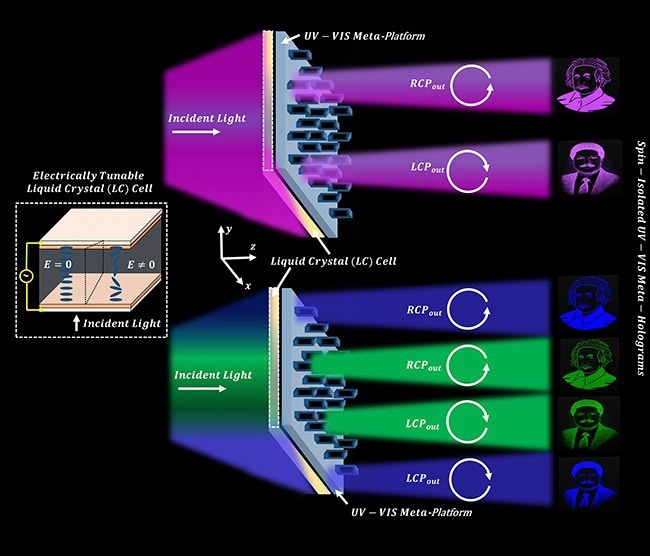Metamaterials include artificially engineered substances that come with properties not found in the environment naturally.

(Left) When an electric field is not applied, the liquid crystal cells align linearly, causing the light to spin clockwise. Conversely, when an electric field is applied, the arrangement of the liquid crystal cells becomes non-linear, resulting in the light spinning in a different direction. (Right) The new approach facilitates the generation of two distinct holograms by designing them to be responsive to the direction of the light. Image Credit: Pohang University of Science and Technology
Metasurfaces, defined by their lightness and thinness, have reaped significant interest as a likely component for integration into portable virtual reality (VR) and augmented reality (AR) devices to enable holographic generation. However, it is essential to observe that metasurfaces have natural restrictions, like their inadequate ability to store data and their capacity to produce holograms merely within the visible spectrum.
The research team with Professor Junsuk Rho from the Department of Mechanical Engineering and the Department of Chemical Engineering and Joohoon Kim from the Department of Mechanical Engineering at Pohang University of Science and Technology (POSTECH) has accomplished the production of meta-holograms applicable to the visible and ultraviolet spectral regions. The study outcomes have been published on the inside front cover of Nanoscale Horizons, a respected international journal.
The limitation of hologram generation to the visible spectral range has been mainly accredited to light absorption demonstrated by most objects in the ultraviolet regime. The study group, however, has successfully resolved this difficulty by incorporating a thin layer of uniquely formulated gas compositions into the metasurfaces, in return attaining considerable improvements in holographic transmission efficacy within the visible and ultraviolet regimes.
In addition, the group has achieved the encoding of two separate holographic phase profiles onto a single metasurface. The polarization features of light direct its propagation via space. Using this phenomenon, the approach of the team allows the provision of holographic information for clockwise circularly polarized light and counter-clockwise circularly polarized light, successfully doubling the quantity of data encoded onto metasurfaces.
To enable practical application, the team used liquid crystal, a commonly employed component in LCD displays and cellphones, enabling suitable manipulation of the light’s spin direction. The experimental findings exhibit that in the absence of an electric field, the light shows clockwise spinning, in turn producing a type A hologram.
On the other hand, the implementation of an electric field promotes a variety of light spinning directions, which results in the production of a type B hologram. Basically, the research group developed a device that has the ability to present separate holograms depending on the existence or non-existence of an electric field.
This study is significant in that it overcomes the limitations associated with meta-holograms solely applicable to the visible regime and we have achieved the concurrent generation of meta-holograms in both the visible and the UV domains. This proposed metasurface can have promising applications in security technologies such as anti-counterfeiting measures, identifications, and passports.
Professor Junsuk Rho, Study Lead Author, Pohang University of Science and Technology
The research was done with the support of the STEAM Research Program (Center for Nano-optics-based Smart Data Security Technology) of the National Research Foundation of Korea funded by the Ministry of Science and ICT and a program of POSCO’s Industry-Academic Integrated Research Center.